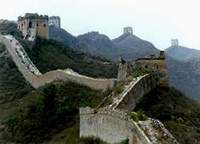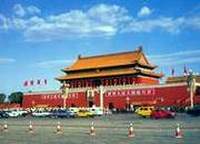|
Beijing
As the capital
of the People's Republic of China, Beijing ( Its former
English name is Peking ) is the national political and
cultural center. It's both an old and a new city--old in its
cultural heritage and new as the capital of the
country.
 The story of Beijing dates back
long before the recorded history. The fragments of the bones
of "Peking Man", dated to a period about 300,000----500,000
years ago, were discovered in a village to the southwest of
the present-day city. In the same area, the fossils of the
"Upper Cave Man" dating back 18,000 years were also
found. The story of Beijing dates back
long before the recorded history. The fragments of the bones
of "Peking Man", dated to a period about 300,000----500,000
years ago, were discovered in a village to the southwest of
the present-day city. In the same area, the fossils of the
"Upper Cave Man" dating back 18,000 years were also
found.
In the later
1,000 years, it has been China's political and cultural
center. Beijing was established as the secondary capital of
the Liao Kingdom (916-1125) in 938. In the Jin Kingdom
(1115-1234), Beijing began to serve as the central capital in
1151.
In 1263, just
before the Yuan Dynasty (1271-1368) was founded, Beijing was
made by Kublai Khan the Great Capital and a grand metropolitan
city which became the center of international cultural
exchanges in the Orient. The foundation of the layout of
present Beijing was laid in 1404, when the Ming Dynasty
(1368-1644) decided to move the capital from Nanjing to
Beijing and started a large-scale construction. Many of the
ancient palace buildings, temple structures and gardens that
are still visible today can be traced back to this period or
later.
 Weak Ming rulers and corrupt
bureaucrats finally doomed the Ming Dynasty. The last Ming
emperor hanged himself behind the Imperial Palace and the Qing
succeeded the Ming and ruled China in Beijing from 1644 to
1911. Weak Ming rulers and corrupt
bureaucrats finally doomed the Ming Dynasty. The last Ming
emperor hanged himself behind the Imperial Palace and the Qing
succeeded the Ming and ruled China in Beijing from 1644 to
1911.
Following the
1911 revolution that overthrew the Qing Dynasty, Beijing
became the area of important political events, such as the May
Fourth Movement. On October 1, 1949, Beijing became the
capital of the People's Republic of China, while it has a
whole area of 16808 sq km (about 6500 sq mi).
Today's Beijing
is mingled with tradition and modernity. While seeking for
industrialization, the Government is also carrying out a
conservation program to protect the traditional houses in the
downtown area to partly maintain Beijing's original
outlook.
The city has
many places of historic interest and scenic beauty, including
the Forbidden City, the largest and best-preserved ancient
architectural complex in the world; the Temple of Heaven,
where Ming and Qing emperors performed solemn rituals for
bumper harvests; the Summer Palace, the emperors' magnificent
garden retreat; the Ming tombs, the stately and majestic
mausoleums of 13 Ming Dynasty emperors; and the world-renowned
and genuinely inspiring Ba-da-ling section of the Great
Wall.
 Large-scale construction since the
founding of the People's Republic of China in 1949 has brought
great changes to Beijing. Today's Beijing still retains the
alluring fascination of an ancient capital, but has added a
small forest of skyscrapers and a complete range of municipal
facilities, transforming itself into an attractively modern
metropolis redolent of history. Large-scale construction since the
founding of the People's Republic of China in 1949 has brought
great changes to Beijing. Today's Beijing still retains the
alluring fascination of an ancient capital, but has added a
small forest of skyscrapers and a complete range of municipal
facilities, transforming itself into an attractively modern
metropolis redolent of history.
Beijing's city
emblem trees are the Chinese Scholartree and the arborvitae.
It's city emblem flowers are the China rose and chrysanthemum.
Smoking is not allowed in public places such as hospitals,
office buildings, theatres, cinemas, museums, planes, and
trains.
Welcome to Beijing. | 